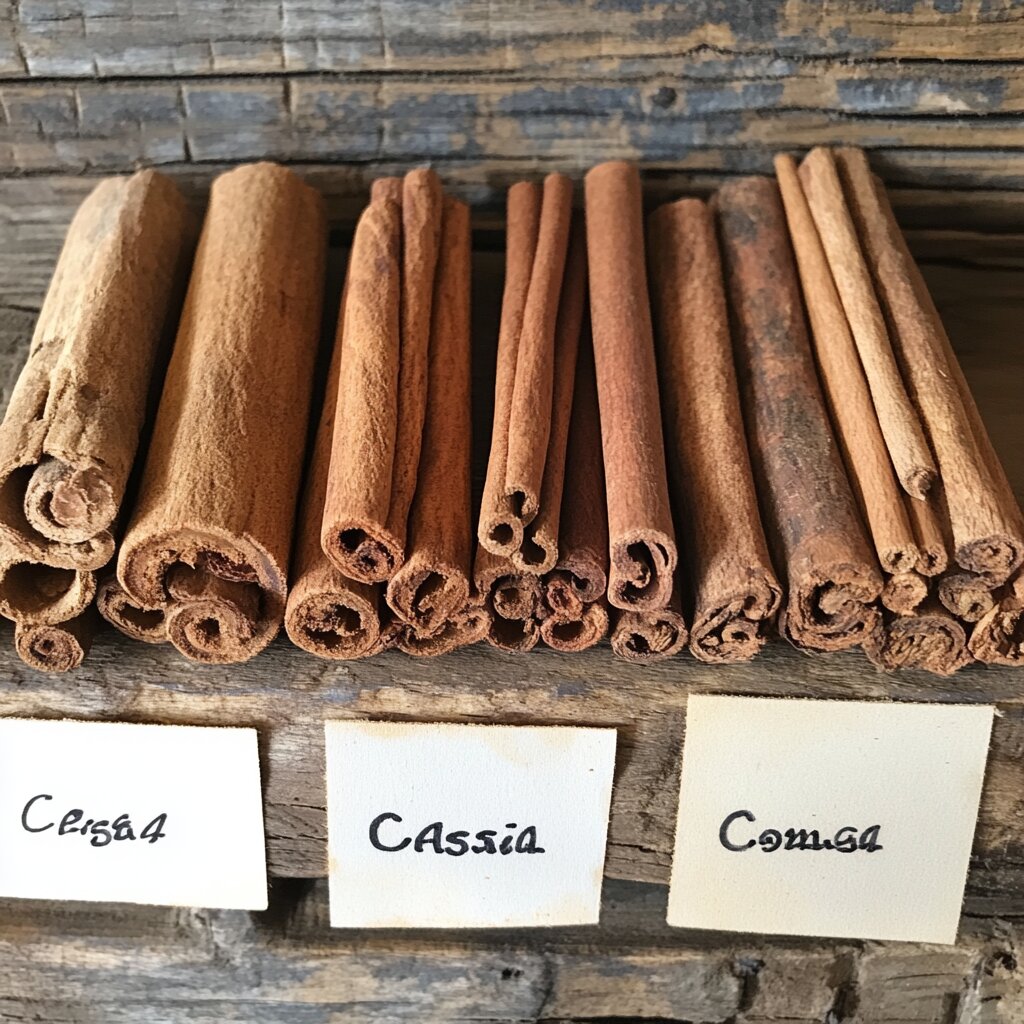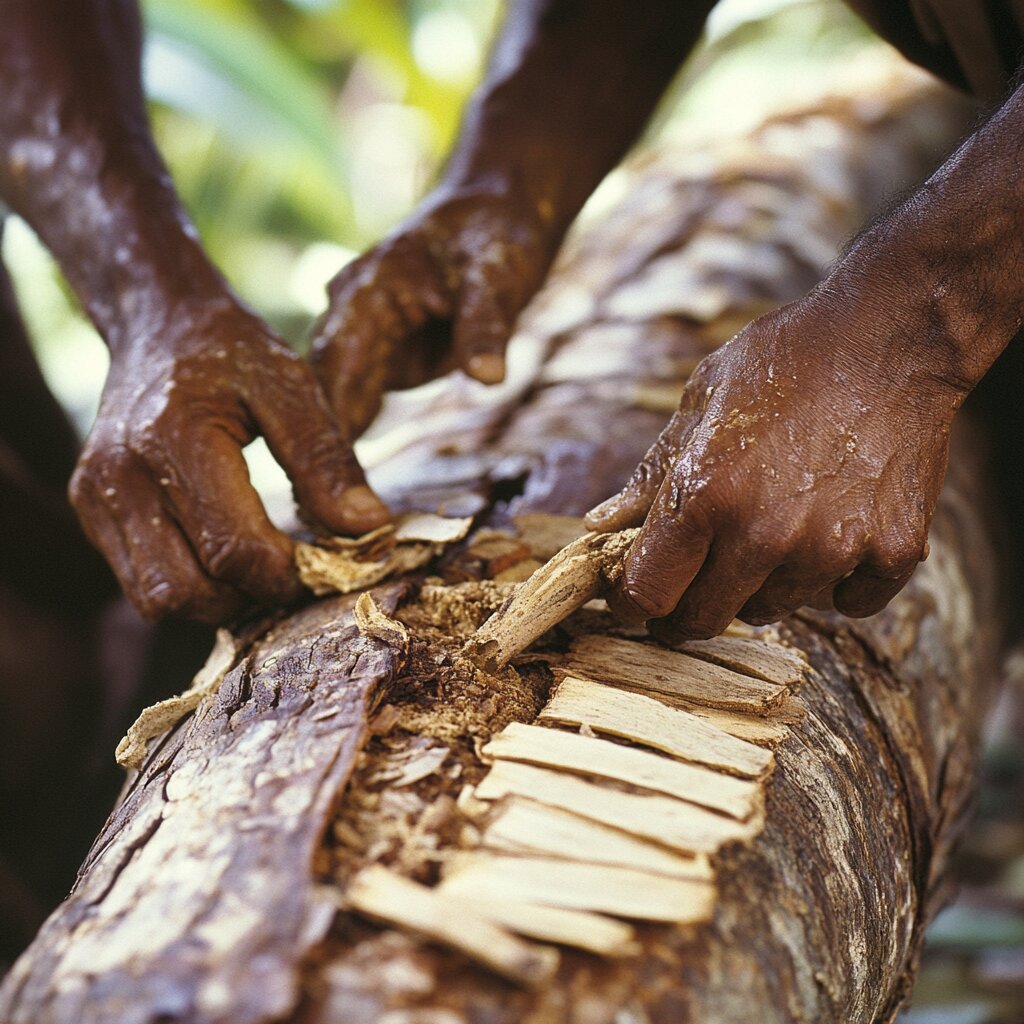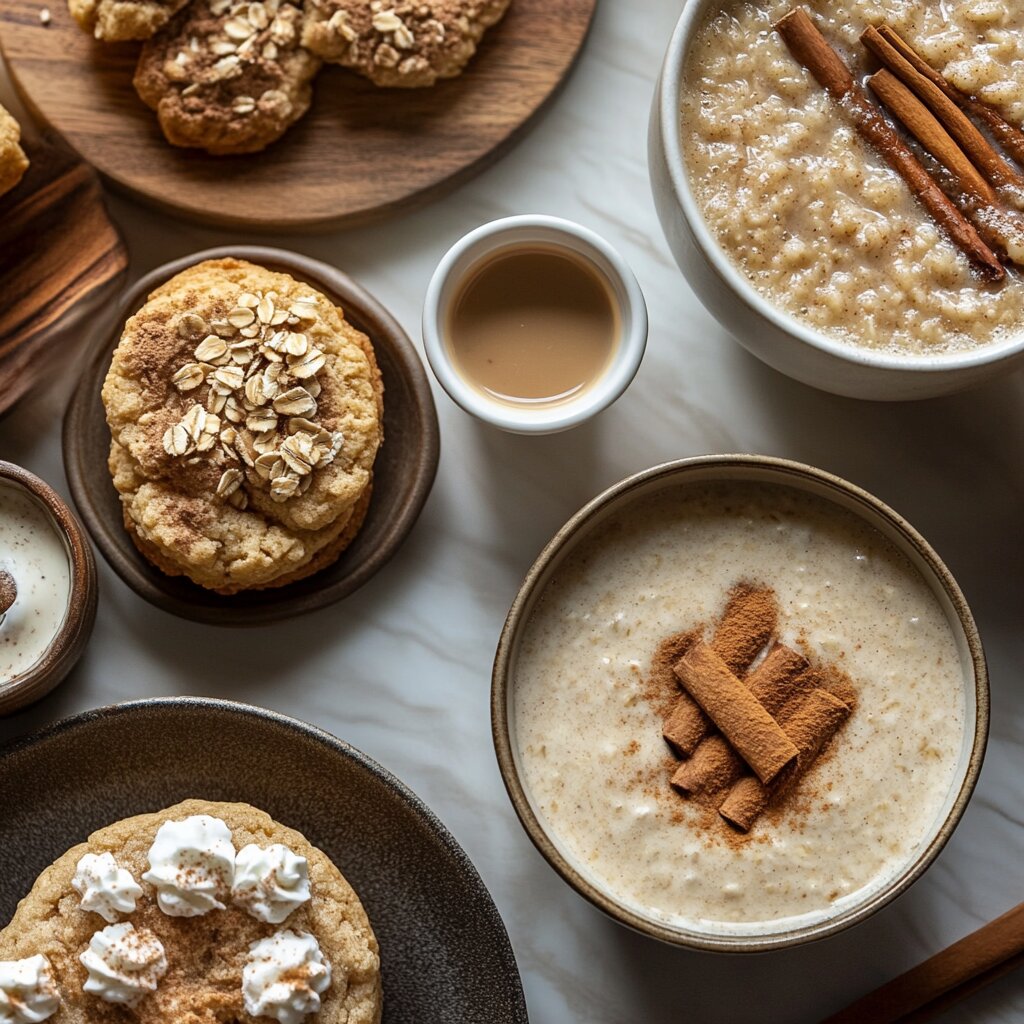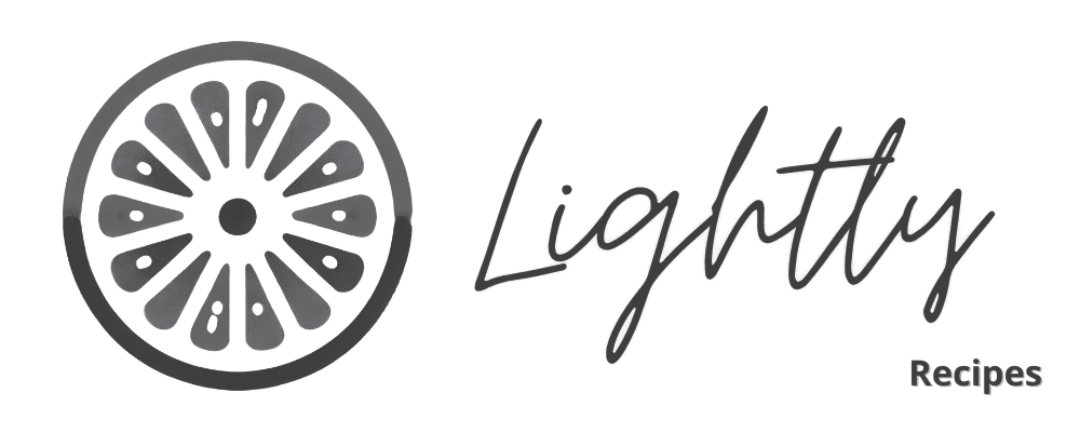
Table of Contents
What is Cinnamon Made Out Of? An Introduction
What is Cinnamon Made Out Of? Cinnamon comes from the inner bark of Cinnamomum trees. Many people ask, ‘What is cinnamon made out of?’ because of its distinctive flavor and aroma.. This versatile spice enhances both sweet and savory dishes, making it a staple worldwide. In ancient Egypt, cinnamon served important purposes in religious ceremonies and embalming. Today, people recognize cinnamon for its potential health benefits, including antioxidant and anti-inflammatory properties. Additionally, different types of cinnamon allow users to select the best option based on their needs—whether for cooking, baking, or health purposes.
Brief History of Cinnamon
Cinnamon’s history dates back over 4,000 years. Ancient Egyptians used it for embalming and religious rituals. In biblical times, people associated cinnamon with luxury and status. During the Middle Ages, Arab merchants controlled the spice trade and kept its source a secret. Consequently, European explorers in the 15th century sought direct routes to the East to obtain cinnamon. Eventually, the Dutch and British seized control of cinnamon production in Sri Lanka. This pursuit of cinnamon significantly influenced global trade and exploration.
What is Cinnamon Made Out Of? Exploring the Types of Cinnamon
There are four main types of cinnamon: Ceylon, Cassia, Saigon, and Korintje. Each type offers a unique flavor and aroma, making them suitable for different uses.
Ceylon Cinnamon
Many people wonder, “What is cinnamon made out of?” When discussing cinnamon types and uses, Ceylon cinnamon, also known as “true cinnamon,” originates from Sri Lanka. It has a delicate, sweet flavor and a light brown color. The thin bark forms multiple layers when rolled. Because of its low coumarin content, Ceylon cinnamon is the healthiest option. Therefore, it works well in desserts, beverages, and gourmet recipes.
Cassia Cinnamon
In exploring cinnamon types and uses, Cassia cinnamon is the most common type found in stores. It has a stronger, more intense flavor and a dark brown color. The bark is thicker and harder than Ceylon cinnamon. Although affordable, Cassia contains higher levels of coumarin, which can harm the liver if consumed excessively. For this reason, it suits baked goods, savory dishes, and everyday cooking.
Saigon Cinnamon
Saigon cinnamon comes from Vietnam and offers a bold, spicy flavor. Its high cinnamaldehyde content gives it a stronger taste. Consequently, Saigon cinnamon works well in recipes that require a pronounced flavor, such as cinnamon rolls and spiced drinks. However, it also contains high levels of coumarin, so moderation is necessary.
Korintje Cinnamon
Korintje cinnamon, grown in Indonesia, is popular in commercial baking. It has a mild, sweet flavor and a darker color than Ceylon cinnamon. Many bakeries use it because of its consistent quality and low cost. Nevertheless, like Cassia and Saigon, it contains higher levels of coumarin. For home bakers, Korintje is a reliable choice for affordable, everyday use.
How Cinnamon is Produced
Harvesting Cinnamon Bark

To fully understand what is cinnamon made out of, farmers harvest it by carefully peeling the inner bark of Cinnamomum trees. This process usually occurs during the rainy season, which makes the bark easier to remove. First, workers strip away the outer bark. Then, they access the valuable inner layer, which eventually becomes the cinnamon used in cooking and baking.
Processing the Bark
After harvesting, the bark undergoes several steps to become the final product.
- Drying and Curing: The inner bark is rolled into quills and left to dry. As a result, the quills curl and harden.
- Grinding into Powder: Once dried, workers grind the quills into fine powder. This powder is then ready for use in various recipes.
What is Cinnamon Made Out Of?
Inner Bark of the Cinnamomum Tree
Cinnamon comes from the inner bark of Cinnamomum trees. Farmers first strip away the outer bark to reach the valuable inner layers. These inner layers contain essential oils and compounds that give cinnamon its unique flavor and aroma. After harvesting, the bark is dried and processed into quills or ground into powder, making it ready for use.
Chemical Compounds in Cinnamon
Cinnamon’s flavor and health properties come from its key compounds.
- Cinnamaldehyde: This compound gives cinnamon its characteristic taste and aroma. Additionally, it has antimicrobial properties.
- Eugenol: Found more in Ceylon cinnamon, eugenol adds a clove-like scent.
- Coumarin: This compound occurs in higher amounts in Cassia varieties. In large doses, coumarin can harm the liver.
Health Benefits of Cinnamon
Anti-Inflammatory Properties
Cinnamon contains powerful compounds that help reduce inflammation. Inflammation contributes to many chronic diseases, such as arthritis, heart disease, and certain cancers. Therefore, including cinnamon in your diet may alleviate symptoms of these conditions. Studies show that cinnamaldehyde, one of cinnamon’s primary compounds, blocks inflammatory pathways. As a result, it helps reduce swelling and pain. Additionally, cinnamon’s anti-inflammatory properties may benefit those with muscle soreness or injuries. To achieve the best results, pair cinnamon with a balanced diet that includes other anti-inflammatory foods like fruits, vegetables, and whole grains. Although cinnamon offers benefits, use it in moderation, especially Cassia varieties, due to their high coumarin content.
Antioxidant Benefits
Cinnamon provides a rich source of antioxidants, which protect the body from oxidative stress. Free radicals, unstable molecules, cause cell damage and accelerate aging. Fortunately, antioxidants neutralize these free radicals and support overall health. Cinnamon contains polyphenols, a type of antioxidant that helps lower the risk of chronic illnesses like heart disease and diabetes. Some studies even suggest that cinnamon ranks higher in antioxidant content than other popular spices, such as garlic and oregano. Including cinnamon in your diet can boost your body’s defenses and improve well-being. To maximize these benefits, try adding cinnamon to smoothies, oatmeal, or yogurt.
Blood Sugar Control
One of cinnamon’s most recognized benefits is its ability to regulate blood sugar levels. This makes it particularly helpful for people with type 2 diabetes or insulin resistance. Research shows that cinnamon increases insulin sensitivity, allowing the body to use insulin more effectively. As a result, blood sugar levels decrease. Cinnamon also slows the breakdown of carbohydrates in the digestive system, causing a more gradual release of glucose into the bloodstream. For those managing blood sugar, incorporating half a teaspoon of cinnamon into daily meals may help. However, consult a healthcare professional before using cinnamon as a supplement, especially if you take medication for diabetes.
Culinary Uses of Cinnamon

Cinnamon in Baking
Cinnamon remains a staple in baking, enhancing a wide range of sweet treats. From classic cinnamon rolls to spiced cookies and cakes, this versatile spice adds warmth and depth to baked goods. Its ability to complement ingredients like sugar, vanilla, and chocolate makes it essential in many dessert recipes. Additionally, cinnamon pairs well with fruits like apples, pears, and bananas, making it perfect for pies, tarts, and muffins. When baking, choose the right type of cinnamon for your needs. Ceylon cinnamon offers a delicate sweetness, while Cassia or Saigon cinnamon provides a stronger, more robust flavor. Cinnamon’s warm aroma also makes it ideal for holiday treats like gingerbread and spiced cakes.
Cinnamon in Beverages
Cinnamon adds a rich, aromatic flavor to both hot and cold beverages. Many people enjoy it in drinks like coffee, tea, and hot chocolate. For instance, a sprinkle of cinnamon in a cappuccino or latte creates a comforting, spiced flavor. You can also steep cinnamon sticks in mulled wine or apple cider for a festive touch. In addition, cold beverages like smoothies and iced teas benefit from a hint of cinnamon. Traditional drinks, such as chai tea and horchata, also rely on cinnamon for flavor. Because of its versatility, you can use cinnamon as a garnish, an infusion, or a primary flavor in both alcoholic and non-alcoholic beverages.
Cinnamon in Savory Dishes
Although many associate cinnamon with sweets, it also enhances savory dishes. Many Middle Eastern, Indian, and North African recipes use cinnamon to add depth and complexity. For example, Moroccan tagines, Indian biryanis, and Middle Eastern meat stews benefit from cinnamon’s earthy notes. It balances the richness of meats and vegetables, making flavors more vibrant. Additionally, cinnamon works well in sauces, curries, and marinades. In some cuisines, people combine cinnamon with spices like cumin, coriander, and cardamom to create unique blends. When trying cinnamon in savory dishes, start with a small amount. Its potent flavor can overwhelm the dish if overused.
Cinnamon in Traditional Medicine
Ayurvedic Uses
In Ayurvedic medicine, practitioners have used cinnamon for thousands of years because of its warming properties and health benefits. They believe it improves digestion, boosts circulation, and balances the body’s energy. Many remedies use cinnamon to address respiratory issues like colds, coughs, and bronchitis. Additionally, Ayurvedic treatments often include cinnamon to alleviate joint pain, regulate blood sugar, and enhance vitality. For digestive issues, a mixture of cinnamon, honey, and warm water can promote gut health and relieve bloating. People also use cinnamon in Ayurvedic teas and tonics to strengthen immunity and reduce fatigue. Although cinnamon offers many benefits, consult an Ayurvedic practitioner or healthcare professional before using it as a remedy.
Traditional Chinese Medicine
Traditional Chinese Medicine (TCM) highly values cinnamon for its warming and invigorating qualities. Practitioners believe it promotes the flow of “Qi” (energy) and improves circulation. Many use cinnamon to treat ailments related to cold conditions, such as chills, poor circulation, and cold extremities. Additionally, cinnamon helps relieve menstrual cramps, joint pain, and respiratory infections. Practitioners often combine cinnamon with other herbs like ginger to create balanced formulations. In TCM, cinnamon bark (Rou Gui) strengthens the kidneys and invigorates energy. Meanwhile, cinnamon twig (Gui Zhi) helps promote sweating and relieve muscle tension. As with any traditional remedy, seek guidance from a qualified TCM practitioner before using cinnamon medicinally.
Side Effects and Risks of Cinnamon
Effects of High Coumarin Content
Cinnamon, especially Cassia varieties, contains a compound called coumarin. In small amounts, coumarin is generally safe. However, consuming large quantities can damage the liver and increase the risk of toxicity. Because Cassia, Saigon, and Korintje cinnamon contain high levels of coumarin, frequent use may pose health risks. Ceylon cinnamon, on the other hand, has much lower coumarin content, making it a safer option for regular use. To minimize risk, aim to use Cassia varieties in moderation. If you have liver issues or take medications that affect liver function, consult your healthcare provider before consuming cinnamon regularly. Therefore, choosing the right type of cinnamon is essential for protecting your health.
Potential Allergic Reactions
While cinnamon offers many benefits, some individuals may experience allergic reactions. Symptoms can range from mild to severe, including skin rashes, itching, and swelling. In some cases, consuming cinnamon may trigger respiratory issues, such as coughing or shortness of breath. This is more likely to happen when inhaling ground cinnamon, such as during baking or food preparation. If you experience any adverse reactions, stop using cinnamon immediately and seek medical advice. Additionally, people with a known sensitivity to other spices should be cautious when consuming cinnamon. Patch tests or allergy testing can help determine whether cinnamon is safe for you.
How to Identify High-Quality Cinnamon
Visual Identification
You can often identify high-quality cinnamon by examining its appearance. Ceylon cinnamon, known as “true cinnamon,” has thin, light brown quills with multiple layers. These quills resemble a tightly rolled cigar. In contrast, Cassia cinnamon has thick, dark brown quills that curl inward from both edges, forming a hollow tube. Additionally, Ceylon cinnamon’s surface appears smoother and more delicate, while Cassia’s texture is rougher and more rigid. If you purchase cinnamon sticks, breaking them can also help with identification. Ceylon cinnamon breaks easily and crumbles, while Cassia cinnamon is harder and more difficult to snap. Therefore, understanding these visual differences helps you choose the right cinnamon for your needs.
Smell and Taste Differences
High-quality cinnamon also stands out by its aroma and taste. Ceylon cinnamon has a mild, sweet, and slightly citrusy scent. Its flavor is delicate and subtly sweet, making it ideal for desserts and beverages. On the other hand, Cassia cinnamon offers a stronger, spicier aroma with a hint of bitterness. Its bold flavor works well in dishes that require a more intense cinnamon presence, such as savory recipes and robust baked goods. To test the quality, rub a small piece of cinnamon between your fingers and smell it. A strong, pleasant aroma indicates freshness and quality. Additionally, tasting a small amount can help you determine its intensity and flavor profile.
FAQs About Cinnamon
Is Cassia or Ceylon Cinnamon Better?
The choice between Cassia and Ceylon cinnamon depends on your needs. Ceylon cinnamon, often called “true cinnamon,” has a mild, sweet flavor and low coumarin content, making it the healthier option for frequent use. Cassia cinnamon, however, has a stronger, spicier taste and is more affordable. It works well in recipes that require bold flavors. If you are concerned about coumarin intake or use cinnamon regularly, Ceylon cinnamon is the better choice. However, for occasional use in baking or cooking, Cassia cinnamon is perfectly suitable.
How is Cinnamon Harvested?
Harvesting cinnamon involves peeling the inner bark of Cinnamomum trees. Farmers first cut the outer bark and remove it to reveal the inner layer. Then, they carefully peel off the inner bark in long strips. These strips are rolled into quills and left to dry. Once dried, the quills curl and harden, creating the cinnamon sticks you find in stores. The process requires skill and precision to ensure high-quality cinnamon.
Can Cinnamon Go Bad?
Cinnamon does not spoil easily, but it can lose its potency over time. Ground cinnamon typically stays fresh for 6-12 months, while cinnamon sticks can last up to 2-3 years if stored properly. To maintain freshness, store cinnamon in an airtight container in a cool, dark place. If cinnamon loses its aroma or flavor, it is time to replace it.
What is the Best Way to Store Cinnamon?
To keep cinnamon fresh, store it in an airtight container away from heat, light, and moisture. A pantry or cupboard works well for this purpose. Avoid storing cinnamon near the stove or in the refrigerator, as temperature fluctuations can cause it to degrade faster. If stored properly, ground cinnamon can last up to a year, while cinnamon sticks can remain fresh for several years.
Is Cinnamon Safe During Pregnancy?
Cinnamon is generally safe in small amounts during pregnancy, such as those used in cooking or baking. However, consuming large doses or using cinnamon supplements may pose risks. Cassia cinnamon contains coumarin, which may affect liver function and blood clotting. Therefore, it is best to consult your healthcare provider before using cinnamon supplements or consuming large amounts during pregnancy.
What Does Cinnamon Taste Like?
Cinnamon offers a warm, sweet, and slightly spicy flavor. The taste varies depending on the type. Ceylon cinnamon has a mild, delicate sweetness, while Cassia cinnamon provides a stronger, more intense spice. Saigon cinnamon has a bold, peppery flavor, and Korintje cinnamon is known for its balanced sweetness. These variations make cinnamon a versatile spice for both sweet and savory dishes.
Conclusion
So, what is cinnamon made out of? It’s a versatile spice with a rich history, diverse culinary applications, and valuable health benefits.. The different varieties, including Ceylon, Cassia, Saigon, and Korintje, offer unique flavors suited to various recipes. Incorporating cinnamon into your diet provides anti-inflammatory properties, antioxidant support, and aids in blood sugar regulation. For a tasty treat, try these Cinnamon Sugar Muffins that highlight the spice’s sweet warmth. If you’re curious about dietary compatibility, explore Is Cinnamon Vegetarian? A Comprehensive Guide. Additionally, for a unique baking twist, you can experiment with this Matcha Muffin Recipe with Almond Flour. By understanding the different types of cinnamon, their benefits, and proper uses, you can enhance your cooking while making informed, health-conscious choices. This remarkable spice offers endless possibilities for flavor and wellness.
